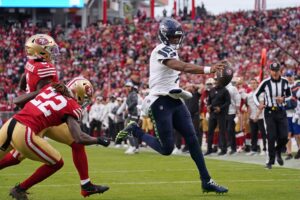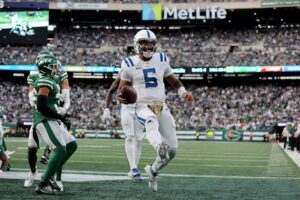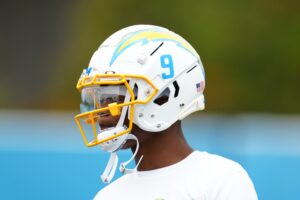The San Francisco 49ers are now officially more than halfway through their 2020 season. They sit at 4-5, amid a nearly unprecedented barrage of injuries. Despite these health hardships, the 49ers are still within the periphery of playoff contention due to the extended postseason format the league has implemented. Here are the 49ers’ midseason grades on offense.
San Francisco 49ers Midseason Grades on Offense
Passing Offense
Due to the astounding amount of injuries the offense has suffered this year, it’s been challenging to develop the same type of rhythm consistently that this offense had last year in the passing game. Jimmy Garoppolo, George Kittle, and Deebo Samuel have all missed extended time so far this season. When a team loses their starting quarterback and two best options in their aerial attack, that passing game is going to understandably suffer relative to what it can do at full strength. Even when Garoppolo was healthy enough to be out on the field this season, he just wasn’t able to generate enough zip on his passes downfield. He was best when able to get the ball out quickly on short passes and let his receivers create after the catch. Whether it was physical, mental, or both, there were numerous points this season that Garoppolo didn’t look the same as he did last year.
There’s a stark line concrete that needs to be drawn between the injuries and the poor decision making, though. There were decisions he made last year at times that seemed nonsensical, and there were a few throws this season that seemed so ill-advised that it’s hard to blame the injury for them. It was just bad decision making, made worse by the separate fact that he wasn’t able to plant his back foot to generate enough thrust on the passes.
Nick Mullens and C.J. Beathard have shown glimpses of effectiveness this season, but there’s a reason they’re Garoppolo’s backups. The offensive line has been inconsistent throughout the season. The interior line’s inability to hold up against the pass rush is why Garoppolo is on the mend. Kittle still leads the team in catches and yards and is tied for the lead in touchdowns despite having played in only six games this season. He’s just immensely important to what they try to do on offense. A piece of good news in an otherwise disappointing season is that first-round pick Brandon Aiyuk has shown remarkable athleticism in racking up yards after the catch. This passing offense can be explosive if Kittle, Samuel, and Aiyuk are ever able to get on the field together for an extended length of time.
This unit has managed to generate big plays, as they currently rank seventh in the league in yards per pass attempt, but struggle with turning the ball over, as they rank sixth in the league in highest interception percentage. Cutting down those interceptions would keep their offense out on the field longer and allow more drives to conclude with points on the board. Their touchdown pass percentage his dipped from 5.9 percent last season to 4.2 percent this season as well. That’s a drop from fifth in the league to 22nd. There’s also been a drop in quarterback rating compared to last season. The team has gone from 103.1, which ranked seventh, to 93.1, which ranks 19th. A lot of this is obviously due to instability at quarterback. Despite that chaos, though, there have still been flashes of brilliance in the passing game from the numerous receiving weapons this team can deploy. The challenge has been getting them all healthy at once.
Passing Offense Grade: C
Rushing Offense
As presently constructed, this offense is most effective when the run game gets established early. Creative play calling that utilizes motion and misdirection allows for explosive running backs to accelerate through holes that materialize and gain huge chunks of yards downfield. Once this dynamic run game continues to gash the defense, the defenders become vulnerable to the play-action pass over the top. When the play-action works, there will be open receivers with plenty of separation down the field, and the quarterback can make the easy throw. The ball gets delivered to the open receiver, and they are then able to use their agility in the open field to rack up yards after the catch.
That’s the basic formula this offense uses to be successful. The offensive line has looked much more consistent in run blocking this season compared to pass blocking, and Kyle Juszczyk is as fantastic of a lead blocker as any running back could ask for in a fullback. The 49ers have the luxury of being able to get meaningful production from third and fourth-string running backs on the roster. Jerick McKinnon has been able to run the ball relatively effectively during the long absences of Raheem Mostert and Tevin Coleman. Mostert leads the team in rushing yards and has posted an excellent 5.9 yards per rush. He looked like one of the best running backs in the league towards the end of last season, and he was picking up right where he left off this year before getting hurt.
Last season, the 49ers made it a priority to establish the run early, use that explosive run game to get ahead, have their defense come up with early stops, and then continue to run the ball from then on out to protect their lead. Since the 49ers have fallen behind more frequently in games this season compared to last season, they’ve had to pass more. They’ve averaged a similar amount of total offensive plays per game this season compared to 2019, but the 49ers averaged about 31.1 run plays per game in 2019, and only about 26.8 run plays per game this season. They were second in rush yards per game last season and led the league in touchdowns.
This season, they’re still accumulating a lot of rushing touchdowns, but they’ve spent way more of this season behind in games than last season, and they’ve had to pass the ball more. They’ve dipped to ranking 14th in the league in yards per rush this season compared to eighth last year, undoubtedly a result of Mostert and Coleman not being in the lineup as frequently this season. This offense is at its best when it leans heavily on the run game, but when facing so many deficits this season, they’ve had to throw the ball more. The dynamic running ability is still there, though. The team has just taken a step back compared to last year due to injuries and the resulting contextual outlook of their games, but this unit still deserves a relatively high mark in the 49ers midseason grades.
Rushing Offense Grade: B
49ers Midseason Grades Overall Offense
It’s a testament to this team’s depth that the offense has still managed to put up the numbers it has despite all their injuries. The 49ers are currently scoring 25 points per game this season. Last season, they scored 29.9 points per game. However, if you take away touchdowns scored on interception returns and fumble recoveries, the team would have averaged about 28 points per game purely off of receiving and rushing touchdowns last season. Given that the 49ers haven’t scored any touchdowns on interception returns or fumble recoveries this season, that means their offense is scoring about the same as it did last season minus one made field goal per game. What’s fascinating is that the 49ers are currently averaging about 5.9 yards per offense play, and that’s only 0.1 off from what this offense produced last season.
Curiously, a point discrepancy to that extent exists with such similar yards per play rates, but there are a few stats that explain it. They were 45 percent on third down last season, but that number has fallen to 42.2 percent this season, leading to more drives ending without points. Another detail to note is their starting field position. Last season, their defense was excellent in not allowing the opposing offense to march too far down the field and ultimately forcing punts that set up good field position. The difference in average field position to start drives this season has been about 4.7 yards further back compared to last season, while the difference in average net yards per drive this season compared to 2019 has been about 2.8 more yards for the offense this year. Their drive lengths in terms of yards haven’t been enough to make up for that field position difference compared to last season. The offense averaged about 381 total yards of offense per game last season on about 63.3 plays per game.
This season, the offense has averaged about 374 total yards of offense per game on about 63.8 plays per game. The offense is averaging 10.4 drives per game this season, which is down from about 11.4 drives per game last season. The point differential would be higher if not for the 49ers improving in the red zone this season. They are averaging about 3.7 red zone attempts per game this year and scoring a touchdown on 69.7 percent of those attempts. Last year, the offense averaged about 3.9 red zone attempts but only scored touchdowns on about 53.2 percent of trips. That translates to about 0.5 more red-zone touchdowns per game this year. Essentially the offense is suffering from a worse starting field position and a lack of continuity that impacts chemistry on third-down conversions.
The entire offense has suffered not just numerous injuries but injuries to key cogs in how they go about trying to win games. It’s a feat in and of itself that the offense has put up the type of production it has under these circumstances. The 49ers midseason grades for their offense can’t deal in hypotheticals, though. Only what has actually been out on the field this season can be considered. The injuries are important contextually to explain the dropoffs, but the dropoffs must be assessed for what they are. This has been an average offense this year. Average might ultimately be good enough to make the playoffs, but they’re missing too many crucial pieces to be considered a serious contender. They need to hope those who haven’t already been ruled out for the year get back sooner rather than later. The 49ers midseason grades leave half a season to improve on them, though, and that’s the beauty of midterm assessments.
49ers Midseason Overall Offensive Grade: C+






